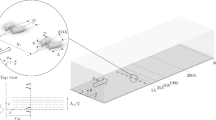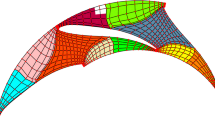Abstract
Cavitation is a widespread and detrimental phenomenon in hydraulic machinery, therefore, it requires to be accurately predicted. In this study, large eddy simulation (LES), scale-adaptive simulation (SAS) and grid-adaptive simulation (GAS) are employed to investigate the unsteady cavitating flow around a NACA0009 hydrofoil. The prediction accuracy of GAS, SAS, both using the shear-stress transport (SST) k — ω model as baseline turbulence model, is validated by comparing with experimental and LES results. The cavity behaviors and turbulence fields are analyzed systematically. Results show that the GAS gives a more reasonable turbulent viscosity and accurately predicts the periodic evolution of typical vortical structures of cavitating flow, such as tip leakage vortex cavitation, tip separation vortex cavitation, leading-edge cavitation, and trailing-edge vortex. The time-averaged cavity volume, volume fluctuation amplitude, and characteristic frequencies of cavities predicted by the GAS are very closed to the LES, while the SAS fails to accurately capture these cavity characteristics. Furthermore, the local trace criterion is applied to extract the vortical structures and to analyze the swirling patterns of the tip leakage vortex. Multi-scale vortical structures in LES are well identified by local trace criterion. The prediction accuracy of the SAS method for small-scale vortical structures, such as the vortex shedding on the suction side and the vortex rope around the tip leakage vortex, is obviously insufficient, while the GAS has a higher accuracy in predicting vortex shedding. The tip leakage vortex and induced vortex extracted from GAS are also closer to that of LES in both swirling patterns and scale.
Similar content being viewed by others
References
Arndt R. E. A. Cavitation in vortical flows [J]. Annual Review of Fluid Mechanics, 2002, 34: 143–175.
Huang B., Qiu S. C., Li X. B. et al. A review of transient flow structure and unsteady mechanism of cavitating flow [J]. Journal of Hydrodynamics, 2019, 31(3): 429–444.
Kadivar E., Ochiai T., Iga Y. et al. An experimental investigation of transient cavitation control on a hydrofoil using hemispherical vortex generators [J]. Journal of Hydrodynamics, 2021, 33(6): 1139–1147.
Huan Y. Y., Liu Y. Y., Li X. J. et al. Experimental and numerical investigations of cavitation evolution in a highspeed centrifugal pump with inducer [J]. Journal of Hydrodynamics, 2021, 33(1): 140–149.
Coutier-Delgosha O., Fortes-Patella R., Reboud J. L. et al. Numerical simulation of cavitating flow in 2D and 3D inducer geometries [J]. International Journal for Numerical Methods in Fluids, 2005, 48: 135–167.
Zwart P. J., Gerber A. G., Belamri T. A two-phase flow model for predicting cavitation dynamics [C]. ICMF 2004 International Conference on Multiphase Flow, Yokohama, Japan, 2004.
Senocak I., Shyy W. Interfacial dynamics-based modelling of turbulent cavitating flows, Part-1: Model development and steady-state computations [J]. International Journal for Numerical Methods in Fluids, 2004, 44: 975–995.
Ghahramani E., Ström H., Bensow R. E. Numerical simulation and analysis of multi-scale cavitating flows [J]. Journal of Fluid Mechanics, 2021, 922: A22.
Coutier-Delgosha O., Fortes-Patella R., Reboud J. L. Simulation of unsteady cavitation with a two-equation turbulence model including compressibility effects [J]. Journal of Turbulence, 2002, 3: 058.
Liebrand R., Klapwijk M., Lloyd T. et al. Transition and turbulence modeling for the prediction of cavitating tip vortices [J]. Journal of Fluids Engineering, 2021, 143(1): 011202.
Cheng H. Y., Ji B., Long X. P. et al. A review of cavitation in tip-leakage flow and its control [J]. Journal of Hydrodynamics, 2021, 33(2): 226–242.
Spalart P. R. Detached-eddy simulation [J]. Annual Review of Fluid Mechanics, 2009, 41: 181–202.
Speziale C. G. Turbulence modeling for time-dependent RANS and VLES: A review [J]. AIAA Journal, 1998, 36(2): 173–184.
Menter F. R., Egorov Y. The scale-adaptive simulation method for unsteady turbulent flow predictions. Part 1: Theory and model description [J]. Flow, Turbulence and Combustion, 2010, 85: 113–138.
Girimaji S. S. Partially-averaged Navier-Stokes model for turbulence: A Reynolds-averaged Navier-Stokes to direct numerical simulation bridging method [J]. Journal of Applied Mechanics, 2006, 73(3): 413–421.
Hou J., Liu Y., Zhong L. et al. Effect of vorticity transport on flow structure in the tip region of axial compressors [J]. Physics of Fluids, 2022, 34(5): 055102.
Liu Y., Xie N., Tang Y. et al. Investigation of hemocompatibility and vortical structures for a centrifugal blood pump based on large-eddy simulation [J]. Physics of Fluids, 2022, 34(11): 115111.
Heinz S. A review of hybrid RANS-LES methods for turbulent flows: Concepts and applications [J]. Progress in Aerospace Sciences, 2020, 114: 100597.
Durbin P. A. Some recent developments in turbulence closure modeling [J]. Annual Review of Fluid Mechanics, 2018, 50: 77–103.
Liu Y., Yu X., Liu B. Turbulence models assess- ment for large-scale tip vortices in an axial compressor rotor [J]. AIAA Journal of Propulsion and Power, 2008, 24(1): 15–25.
Liu Y., Lu L., Fang L. et al. Modification of Spalart-Allmaras model with consideration of turbulence energy backscatter using velocity helicity [J]. Physics Letters A, 2011, 375(24): 2377–2381.
Liu Y. W., Yan H., Fang L. et al. Modified k-ω model using kinematic vorticity for corner separation in compressor cascade [J]. Science China Technological Sciences, 2016, 59(5): 795–806.
Liu Y. W., Yan H., Liu Y. J. et al. Numerical study of corner separation in a linear compressor cascade using various turbulence models [J]. Chinese Journal of Aeronautics, 2016, 29(3): 639–652.
Gao Y., Liu Y., Zhong L. et al. Study of the standard k-ε model for tip leakage flow in an axial compressor rotor [J]. International Journal of Turbo and Jet-Engines, 2016, 33(4): 353–360.
Liu Y., Tang Y., Scillitoe A. D. et al. Modification of shear stress transport turbulence model using helicity for predicting corner separation flow in a linear compressor cascade [J]. Journal of Turbomachinery, 2020, 142(2): 021004.
Li W., Liu Y. Numerical investigation of corner separation flow using Spalart-Allmaras model with various modifications [J]. Aerospace Science and Technology, 2022, 127: 107682.
Li W. H., Liu Y. W. Study of limit to the rotation function in the SA-RC turbulence model [J]. Chinese Journal of Aeronautics, 2023, 36(1): 246–265.
Liu Y., Yan H., Lu L. et al. Investigation of vortical structures and turbulence characteristics in corner separation in a linear compressor cascade using DDES [J]. Journal of Fluids Engineering, 2017, 139(2): 021107.
Yan H., Liu Y., Li Q. et al. Turbulence characteristics in corner separation in a highly loaded linear compressor cascade [J]. Aerospace Science and Technology, 2018, 75: 139–154.
Gao Y., Liu Y. A flow model for tip leakage flow in turbomachinery using a square duct with a longitudinal slit [J]. Aerospace Science and Technology, 2019, 95: 105460.
Liu Y., Zhong L., Lu L. Comparison of DDES and URANS for unsteady tip leakage flow in an axial compressor rotor [J]. Journal of Fluids Engineering, 2019, 141(12): 121405.
Tang Y., Liu Y., Lu L. Solidity effect on corner separation and its control in a high-speed low aspect ratio compressor cascade [J]. International Journal of Mechanical Sciences, 2018, 142–143: 304–321.
Kim S., Pullan G., Hall C. A. et al. Stall inception in low-pressure ratio fans [J]. Journal of Turbomachinery, 2019, 141(7): 071005.
Lopez D. I., Ghisu T., Kipouros T. et al. Extending highly loaded axial fan operability range through novel blade design [J]. Journal of Turbomachinery, 2022, 144(12): 121009.
Rao A. N., Sureshkumar P., Stapelfeldt S. et al. Unsteady analysis of aeroengine intake distortion mechanisms: Vortex dynamics in crosswind conditions [C]. ASME Turbo Expo 2022, Turbomachinery Technical Conference and Exposition, Rotterdam, The Netherlands, 2022.
Matsui K., Tani N., Perez E. et al. Calibrated rotation-helicity-quadratic constitutive relation Spalart-Allmaras (R-H-QCR SA) model for the prediction of multi-stage compressor characteristics [C]. ASME Turbo Expo 2022, Turbomachinery Technical Conference and Exposition, Rotterdam, The Netherlands, 2022.
Wang C., Wang F., Li C. et al. A modified STRUCT model for efficient engineering computations of turbulent flows in hydro-energy machinery [J]. International Journal of Heat and Fluid Flow, 2020, 85: 108628.
Wang C., Wang F., Ye C. et al. Application of the MST turbulence model to predict the tip leakage vortex flows [J]. Engineering Computations, 2021, 38(1): 344–353.
Wang G., Liu Y. A grid-adaptive simulation model for turbulent flow predictions [J]. Physics of Fluids, 2022, 34(7): 075125.
Dreyer M., Decaix J., Münch-Alligné C. et al. Mind the gap: A new insight into the tip leakage vortex using stereo-PIV [J]. Experiments in Fluids, 2014, 55: 1–13.
Liu C., Gao Y. S., Dong X. R. et al. Third generation of vortex identification methods: Omega and Liutex/Rortex based systems [J]. Journal of Hydrodynamics, 2019, 31(2): 205–223.
Wang Y. Q., Gao Y. S., Xu H. et al., Liutex theoretical system and six core elements of vortex identification [J]. Journal of Hydrodynamics, 2020, 32(2): 197–211.
Liu C., Yu Y., Gao Y. S. Liutex based new fluid kinematics [J], Journal of Hydrodynamics, 2022, 34(3): 355–371.
Zhao M. S., Zhao W. W., Wan D. C. et al. Applications of Liutex-based force field models for cavitation simulation [J], Journal of Hydrodynamics, 2021, 33(3): 488–493.
Tang X. R., Dong X. R., Cai X. S. et al., Liutex identification on hairpin vortex structures in a channel based on msfle and moving-PIV [J]. Journal of Hydrodynamics, 2021, 33(6): 1119–1128.
Liu Y., Tang Y. An elliptical region method for identifying a vortex with indications of its compressibility and swirling pattern [J]. Aerospace Science and Technology, 2019, 95: 105448.
Liu Y., Zhong W., Tang Y. On the relationships between different vortex identification methods based on local trace criterion [J]. Physics of Fluids, 2021, 33(10): 105116.
Chong M. S., Perry A. E., Cantwell B. J. A general classification of three-dimensional flow fields [J]. Physics of Fluids A: Fluid Dynamics, 1990, 2(5): 765–777.
Acknowledgements
This work was supported by the National Science and Technology Major Project (Grant No. 2017-II-003-0015), the Aeronautical Science Foundation of China (Grant No. 2018ZB51013) and the Fundamental Research Funds for the Central Universities. The authors also would like to thank Matthieu Dreyer for providing the experimental results.
Author information
Authors and Affiliations
Corresponding author
Ethics declarations
This article does not contain any studies with human participants or animals performed by any of the authors.
Additional information
Conflict of interest
The authors declare that they have no conflict of interest.
Informed consent
Informed consent was obtained from all individual participants included in the study.
Project supported by the National Natural Science Foundation of China (Grant No. 51976006, 52106039).
Biography: Nan Xie (1995-), Male, Ph. D. Candidate
Rights and permissions
About this article
Cite this article
Xie, N., Tang, Ym. & Liu, Yw. High-fidelity numerical simulation of unsteady cavitating flow around a hydrofoil. J Hydrodyn 35, 1–16 (2023). https://doi.org/10.1007/s42241-023-0014-2
Received:
Revised:
Accepted:
Published:
Issue Date:
DOI: https://doi.org/10.1007/s42241-023-0014-2




